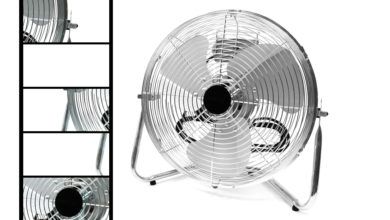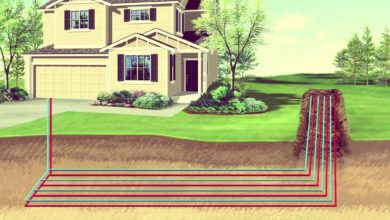All fans work on the same basic principle – by moving the air near them via rotating blades and creating a cool breeze. Or, more specifically, while the air doesn’t really become cooler, it has a cooling effect as it allows our bodies’ heat and sweat to evaporate more quickly and thus – cool us down. The same principle works for other things such as car engines and computer processors which are also cooled with fans.
However, there are some significant differences between the different types of fans – from the size, speed, and direction of the blades, to how they work and what additional functions they might have.
How does an electric fan work?
Electric fans are usually quite simple in their design. They are comprised of an electric motor that powers the movement of the fan blades via a shaft. The motor will usually have different speed settings and electric fans can also come in various shapes, sizes, and models.
Whatever type of electric fan you choose, these are usually the most energy-efficient fans out there which is why they’ve been preferred for residential use for over a century together with – or sometimes even instead of – air conditioning.
How do heat powered fans work?
Also called stove fans, heat powered fans work by generating their own electricity or rather – kinetic energy. They do that by transforming the heat from a stove of a furnace they’re placed on.
Not only is this a pretty unique and 100% energy-efficient way to power a fan but heat powered stove fans also have the opposite purpose to standard electric fans – they don’t aim to cool us down but to distribute the warmth generated from the stove or furnace better around the room.
Essentially, heat powered fans are used as additional heat distribution tools when you want to make your furnace more effective in the winter. This quick video shows heat powered stove fans in work very nicely.
How does exhaust fan work?
Another unique type of fan, exhaust fans are used to regulate moisture levels and odors in a room, usually in bathrooms, toilets, and kitchens. Their purpose isn’t so much to cool down or warm up a certain space but to provide ventilation by removing air – typically humid, stale, and contaminated air – from an enclosed space.
Exhaust fans are often controlled by a wall switch next to the bathroom’s or kitchen’s light switch but they can also be connected to a thermostat for better and more precise control.
Older and simpler apartment building exhaust fans were also designed to work automatically based on the air pressure in the building’s chimney.
Exhaust fans are pretty much essential for any residential or commercial building today as without them toilets, bathrooms, and kitchens can easily reach insufferable moisture or odor levels. What’s more, especially in smaller apartments or office spaces, exhaust fans can help reduce the humidity in the whole place as kitchens and bathrooms can “leak” moisture throughout the rest of the place if said moisture isn’t dealt with.
How does a whole house fan work?
Knowing how a whole house fan works is another curious question. They are usually outclassed by whole-home AC systems but that doesn’t mean that whole house fans don’t serve their own purpose.
Whole house fans work best when the air outside is cooler than the air inside your home. They also work better in places with low humidity, i.e. in drier climates.
That’s because whole house fans are essentially giant exhaust fans for your home – they “exhaust” the stale and warm indoor air from your home through attic vents and pull in fresh air from outside.
These fans are usually used in the early morning when the air outside is cooler and the air inside has grown stale during the night. They can also be used in the evening, however, and many homeonwers turn them on for ~30 minutes to make sure the indoor air will be cool all throughout the night.
As we said, whole house exhaust fans are usually outclassed by air conditioners, however, they are significantly more energy-efficient and can save you a lot of money over time. And, if the climate conditions are just right, a whole house fan can also be very effective, eliminating the need for an AC unit almost completely.





